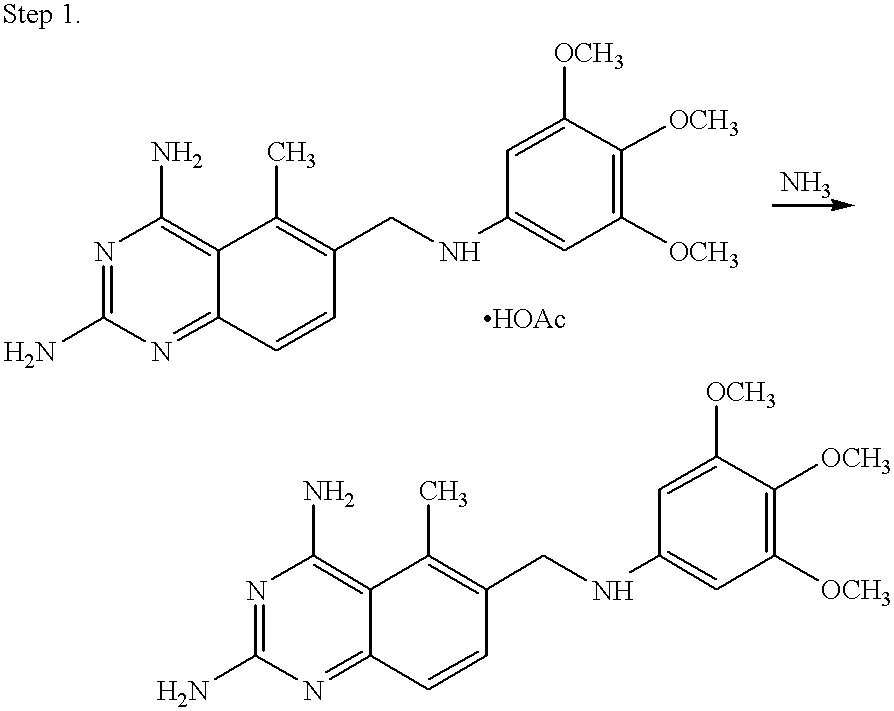Thermally stable trimetrexates and processes for producing the same
a technology of trimetrexate and stable trimetrexate, which is applied in the direction of antibacterial agents, drug compositions, antiparasitic agents, etc., can solve the problems of trimetrexate, trimetrexate, and inability to be stable for long-term storage, so as to improve thermal stability, enhance stability, and facilitate manufacturing characteristics
- Summary
- Abstract
- Description
- Claims
- Application Information
AI Technical Summary
Benefits of technology
Problems solved by technology
Method used
Image
Examples
example 1
6.1. Example 1
X-ray Crystallography of TMH
The molecular and crystal structure of crystalline trimetrexate monohydrate was determined by x-ray diffraction. Crystal survey, unit cell determination, and data collection were performed using Mo-K.alpha. radiation at -175.degree. C. Preliminary analysis of the unit cell constants indicated a triclinic unit cell. Intensity statistics obtained during data collection indicated the presence of a centrosymmetric space group, suggesting the space group P-1. The structure was solved by direct methods.
All non-hydrogen atoms were initially refined using isotropic and then anisotropic temperature factors. Redundant data were averaged, yielding an Rav of 0.065. Hydrogen atoms were located by examination of an electron density difference map but were not refined. After hydrogen atoms were added, three additional cycles of full-matrix refinement were performed.
Data Collection
A clear needle crystal of C.sub.19 H.sub.23 O.sub.3 N.sub.5.H.sub.2 O having ...
example 2
6.2. Example 2
Elemental Analysis of TMH
Two samples of trimetrexate monohydrate were analyzed for carbon, hydrogen and nitrogen content. The results for both samples are presented in Table 7. Trimetrexate monohydrate, C.sub.19 H.sub.23 O.sub.3 N.sub.5.H.sub.2 O, has a molecular weight of 387.44 g / mol. The theoretical values presented in Table 7 are based on the elemental composition of the monohydrate. The data show good agreement with the expected results for the monohydrate.
example 3
6.3. Example 3
Mass Spectrometry
Mass spectra were taken of two samples of trimetrexate monohydrate. The spectra were measured with a Hewlett-Packard 5989A MS Engine mass spectrometer with a hyperbolic quadrupole mass filter. The ionization method was direct electron impact, at an ionization energy of 70 eV. The probe was programmed from 45.degree. C. to 250.degree. C. at a rate of 25.degree. C. / min.
The mass spectra for the two samples were equivalent. Both the molecular ion and the base m / z=187 ion (M.sup.+ minus the trimethoxyanilino moiety) were clearly present. The major fragment ions observed, their relative intensities and assigned identities are presented in Table 8.
PUM
| Property | Measurement | Unit |
|---|---|---|
| temperature | aaaaa | aaaaa |
| pressure | aaaaa | aaaaa |
| temperature | aaaaa | aaaaa |
Abstract
Description
Claims
Application Information
 Login to View More
Login to View More - R&D
- Intellectual Property
- Life Sciences
- Materials
- Tech Scout
- Unparalleled Data Quality
- Higher Quality Content
- 60% Fewer Hallucinations
Browse by: Latest US Patents, China's latest patents, Technical Efficacy Thesaurus, Application Domain, Technology Topic, Popular Technical Reports.
© 2025 PatSnap. All rights reserved.Legal|Privacy policy|Modern Slavery Act Transparency Statement|Sitemap|About US| Contact US: help@patsnap.com



